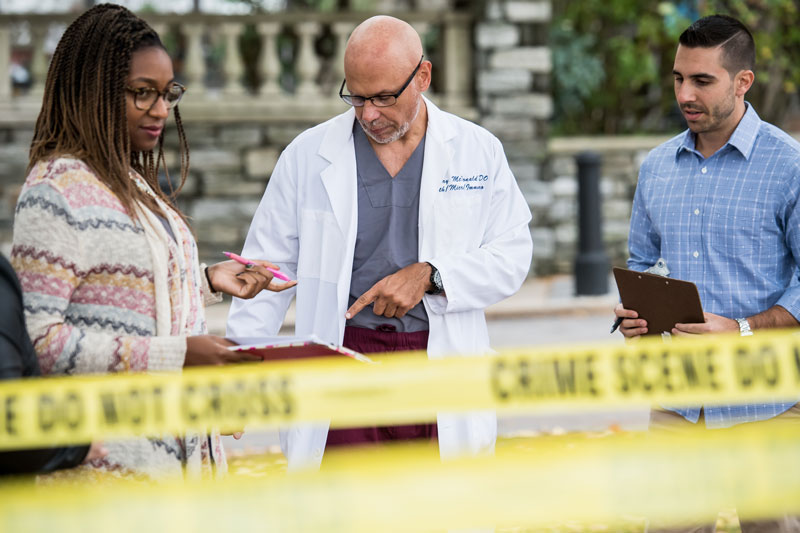What is Forensic Pathology?
November 30, 2023Forensic pathology is a subspecialty of medicine within the field of pathology. Forensic
pathologists predominantly examine deceased individuals to determine the cause and
manner of death.
Gregory McDonald, DO ‘89, professor and chair of PCOM's Department of Forensic Medicine and Pathology, is also the chief deputy coroner of Montgomery County, Pennsylvania. McDonald explains
that the cause of death is the actual injury or disease that initiated the chain reaction
resulting in a person's death, and the manner of death is how the cause of death came
into being.
There are many causes of death—some examples may include a heart attack, breast cancer,
or gunshot wounds—and there are typically five manners of death: natural, accident,
suicide, homicide, and undetermined. The manner of death is based on autopsy findings and various other circumstances surrounding the person’s death.
Forensic Pathologist Education and Work Experience
To become a forensic pathologist, the educational requirements include four years
of medical school, a general pathology residency, and a forensic pathology fellowship. Just as is required
for other physicians, forensic pathologists must pass a board certification exam to
become a licensed, practicing physician. For those not interested in the full medical
school route, there are relevant paths at PCOM, including a master's degree in forensic medicine. Graduates of this program may find roles as investigators or autopsy technicians.
What Does a Forensic Pathologist Do?
Oftentimes, forensic pathologists work in government agencies at the city, county,
and state levels, and a work week might include examining bodies in the form of autopsies
or full body X-rays. In general, an autopsy is performed for any death in which a
criminal legal proceeding may be anticipated, such as homicide cases, and typically
on all children.
In the case of an elderly person who had well-documented medical problems, an autopsy
may not be necessary, and a forensic pathologist may draw blood or perform an external
examination to make sure there was no injury to the body before issuing a natural
death certificate. After a body has been examined, the forensic pathologist will generate
a report that includes toxicology reports and microscopic slides.
Speaking for the Deceased
Another important asset of being a forensic pathologist is testifying in court. McDonald
recalls, “In Philadelphia, I used to go to court at least once or twice a week, and
the vast majority of cases were homicides.” Though at times it can be a somewhat stressful
situation, explaining technical medical concepts to a judge and jury who likely do
not possess medical backgrounds is a valuable skill.
“You’re essentially speaking for the deceased. They can’t speak for themselves, so
we’re trying to describe to the judge and jury exactly how their death came about,”
says McDonald, who finds testifying in court to be an aspect of the job he enjoys.
“You form a rapport with the jury in a relatively short period of time, and we’re
contributing to the medical community, we’re contributing to public health, and we
are the voice of the deceased.”
Doctors of osteopathic medicine (DOs) are trained to consider the entire person. Forensic pathologists may go to the death scene to examine the body and assess the
environment in which they were living. What temperature was the house—was it too hot,
or too cold? Were signs of trauma found in the residence, any drug paraphernalia or
prescribed drugs present, or any indications that the person might have been abusing
alcohol? Forensic pathologists trained as DOs are taking the person's entire way of
life into account to find hints as to what caused their death.
McDonald says it is important for physicians to engage with the patient’s needs even
after death, adding, “By signing a death certificate or providing the information
to those signing the death certificate—from a DO perspective, that's the final service
that they should be doing for their patients.”
Pursuing a Forensic Pathology Career
While considering disciplines to pursue as a student at PCOM, McDonald enjoyed his
histology course—the study of the microscopic structure of tissues—and his pathology
course. “As pathologists, we do dissections, but we also have to be able to look at
things on the microscope,” he says. “I always wanted to see the inside. And so that
kind of drove me.”
Students interested in a career in forensic pathology should be assertive in their
pursuit, because some of the forensics-specific curriculum may not be built into standard medical school courses. McDonald encourages students
to seek relevant opportunities and student organizations geared toward forensics to
ensure that the subspecialty is right for them.
According to the National Association of Medical Examiners, there are currently about 850 forensic pathologists in the United States. This relatively small pool of physicians can prove challenging when considering
increases in causes of deaths such as the opioid epidemic, COVID, and gun violence across the country. “The good news is that we're seeing
a decent amount of young people who are becoming interested in forensics, and we're
doing our best to bring them into the fold,” says McDonald.
In addition to the legal community, forensic pathologists may interact with physicians
in other disciplines, such as toxicologists, to interpret drug samples they are less
familiar with, or with a forensic entomologist if the body becomes exposed to insects
upon its death.
While the job is rewarding, McDonald maintains that the challenges of being a forensic
pathologist can not be understated. As with other fields of medicine and life in general,
forensic pathologists must be able to take care of themselves first before they can
take care of others.
“Sometimes you're interacting more with dead people than with living people,” he says.
“It takes a certain person to be able to do that and compartmentalize that.”
Sometimes, forensic pathologists might be speaking to a family on the worst day of
their lives. “I never get to speak to a happy family. The best thing I can try and
do for them is to provide them with some type of closure,” says McDonald. “Emergency
room doctors have challenges that I can't begin to understand, but they also have
victories—they save people all the time. Our victories are measured very differently.”
You May Also Like:

 To become a forensic pathologist, the educational requirements include four years
of
To become a forensic pathologist, the educational requirements include four years
of 